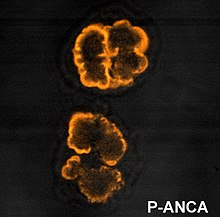p-ANCA
This pattern occurs because the vast majority of the antigens targeted by ANCAs are highly cationic (positively charged) at pH 7.00.
During ethanol (pH ~7.0 in water) fixation, antigens which are more cationic migrate and localize around the nucleus, attracted by its negatively charged DNA content.
By far the most common p-ANCA target is myeloperoxidase (MPO), a neutrophil granule protein whose primary role in normal metabolic processes is generation of oxygen radicals.
[citation needed] ANCA will less commonly form against alternative antigens that may also result in a p-ANCA pattern.
These include lactoferrin, elastase, and cathepsin G.[citation needed] When the condition is a vasculitis, the target is usually MPO.
